The Iwase Bunko Library has in its possession a document entitled Hyouryuukishuu ("Tales of Castaways"), which was printed during the late Edo period (1603-1868).
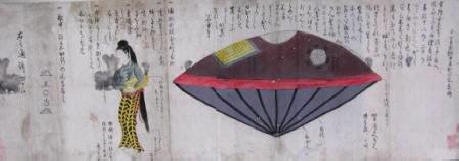
The document recounts the stories of Japanese sailors who find themselves in foreign lands after becoming lost at sea, as well as castaway foreigners washed ashore on the beaches of Japan. To the Japanese people, who at the time had been living in a prolonged period of national isolation, these exotic tales must have seemed very fantastic.
Among these stories is the account of a wrecked ship with a very mysterious appearance.
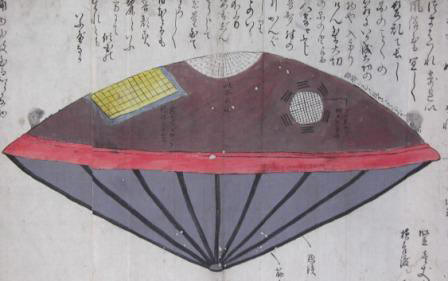
According to the document, this vessel washed ashore at Harashagahama in Hitachi-no-kuni (present-day Ibaraki prefecture). The body of the ship, described as 3.3 meters tall and 5.4 meters wide, had been built from red sandalwood and iron and was fitted with windows of glass or crystal. The mysterious characters of an unknown alphabet were found inscribed inside the vessel.
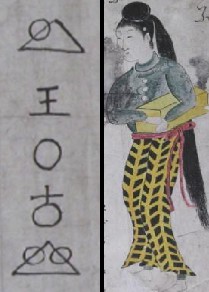 Aboard the drifting vessel was a finely dressed young woman with a pale face and red eyebrows and hair. She was estimated to be between 18 and 20 years old. Because she spoke an unfamiliar tongue, those that encountered her were unable to determine from whence she came. In her arms she clutched a plain wooden box that appeared to be of great value to her, as she would allow nobody to approach it.
Aboard the drifting vessel was a finely dressed young woman with a pale face and red eyebrows and hair. She was estimated to be between 18 and 20 years old. Because she spoke an unfamiliar tongue, those that encountered her were unable to determine from whence she came. In her arms she clutched a plain wooden box that appeared to be of great value to her, as she would allow nobody to approach it.
The document shows a portion of the text found inside the ship (see left).
Other Edo-period documents describe variations of this mysterious encounter. Toen Shousetsu (1825), a book by Kyokutei Bakin (who is most famous for his 106-volume samurai epic Nansou Satomi Hakkenden) tells the story of the same encounter, referring to the strange vessel as the utsuro-fune ("hollow ship"). Another variation of this tale appears in Ume no Chiri (1844), penned by a relatively unknown author named Nagahashi Matajirou. A thorough analysis of these two variations of the story can be found in a translated article by Kazuo Tanaka titled "Did a Close Encounter of the Third Kind Occur on a Japanese Beach in 1803?"
Contemporary fans of the paranormal know this ship as the Edo-period UFO.
[Link: Hyouryuukishuu in the Iwase Bunko Collection]


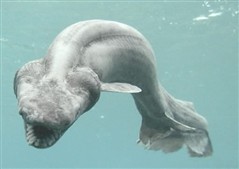 On the afternoon of January 21, a fisherman spotted the large fish in the shallow water near the park. He immediately contacted Awashima Marine Park officials, who caught the shark and transported it to the park's dolphin pen, where they turned it loose. The weak shark was able to survive for several hours -- long enough for park officials to videotape it swimming around. Video footage of the frilled shark near the sea surface is very rare, and the park says it will keep the video for research purposes.
On the afternoon of January 21, a fisherman spotted the large fish in the shallow water near the park. He immediately contacted Awashima Marine Park officials, who caught the shark and transported it to the park's dolphin pen, where they turned it loose. The weak shark was able to survive for several hours -- long enough for park officials to videotape it swimming around. Video footage of the frilled shark near the sea surface is very rare, and the park says it will keep the video for research purposes. 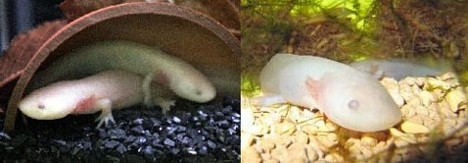


 Aboard the drifting vessel was a finely dressed young woman with a pale face and red eyebrows and hair. She was estimated to be between 18 and 20 years old. Because she spoke an unfamiliar tongue, those that encountered her were unable to determine from whence she came. In her arms she clutched a plain wooden box that appeared to be of great value to her, as she would allow nobody to approach it.
Aboard the drifting vessel was a finely dressed young woman with a pale face and red eyebrows and hair. She was estimated to be between 18 and 20 years old. Because she spoke an unfamiliar tongue, those that encountered her were unable to determine from whence she came. In her arms she clutched a plain wooden box that appeared to be of great value to her, as she would allow nobody to approach it.  A mutant tomato with a face resembling a Chinese lion mask was harvested from a field in the city of Yahata in Kyoto prefecture. The common momotaro tomato is 3 times the normal size, measuring 10 cm in diameter and weighing 150 grams.
A mutant tomato with a face resembling a Chinese lion mask was harvested from a field in the city of Yahata in Kyoto prefecture. The common momotaro tomato is 3 times the normal size, measuring 10 cm in diameter and weighing 150 grams. 


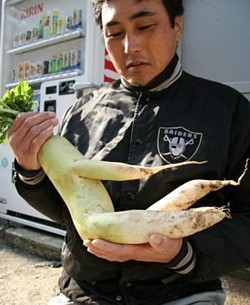 A daikon radish with a distinctly human shape is the talk of the town in Sasamicho, Wakayama prefecture.
A daikon radish with a distinctly human shape is the talk of the town in Sasamicho, Wakayama prefecture.